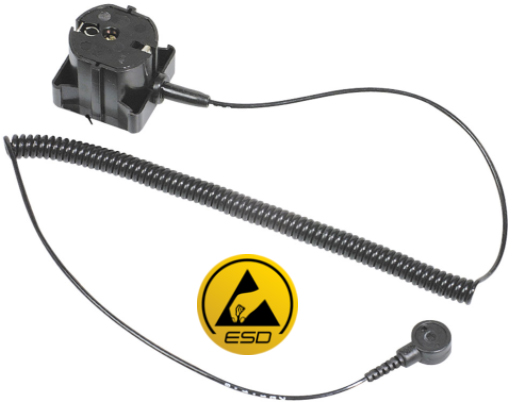ESD Anti Fatigue Mats Guide | Polyurethane vs. Rubber
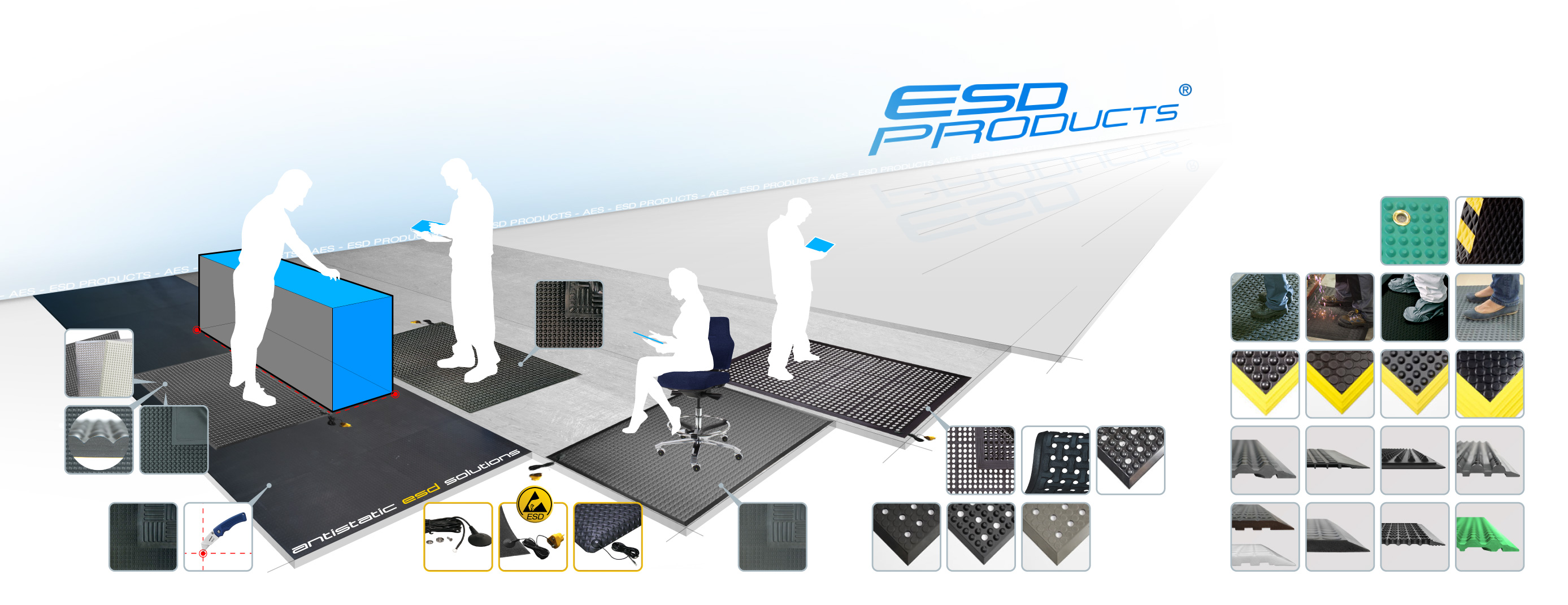
If you feel discomfort or fatigue in your legs or feet when you stand,
Cornell University’s Human Factors and Ergonomics Research Group recommends (PDF)
that you “either use an anti-fatigue mat, wear more comfortable footwear, use an angled foot rest, or sit down.”
Ignoring discomfort and continuing to stand without moving or switching positions can be dangerous:
“Repeated, long term exposure to standing has been implicated in the development of serious health problems,”
April Chambers, assistant professor in the Department of Health and Physical Activity at the University of Pittsburgh, told us in an email interview.
That includes “regenerative joint damage, muscle injury, and circulatory diseases, such as venous disorders, increased stroke risk, and carotid atherosclerosis.”
There’s also an increased risk of injuries for workers who stand for long periods and report musculoskeletal discomfort, she said.
But sitting all day isn’t the solution, either. Research has associated prolonged sitting (aka “Sitting Disease”) with a higher risk of a host of problems,
including heart disease and diabetes, certain cancers, and premature death.
Most experts agree that the best thing to do while you’re working is to keep moving.
Working in sit-stand-move cycles encourages movement, which is better for you than sitting or standing still all day.
As Alan Hedge, professor of ergonomics at Cornell University, puts it: “Movement is important to get blood circulation through the muscles.”
Hedge’s recommended sit-stand-move cycle suggests that you should alternate between sitting and standing up to 16 times per day.
His recommended ideal routine includes 30-minute cycles of 20 minutes of sitting, eight minutes of standing, and two minutes of moving while standing (walking away, stretching, or the like).
Ultimately, though, the absolute amount of time you spend sitting or standing isn’t critical, as long as you alternate between the two and keep moving.

Cornell University Ergonomics Web
The Perils of Sitting
Sitting for more than 1 hour has been shown to induce biochemical changes in lipoprotein lipase activity(an enzyme involved in fat metabolism)
and in glucose metabolism that leads to the deposit of fats in adipose tissue rather than these being metabolized by muscle, and extensive sitting also relates to heart disease risks,
so people are advocating standing to work because this use more muscle activity (burns about 20% more calories).
These changes happen in both fit people who regularly aerobically work out and also unfit and obese people, and regular exercise doesn’t necessarily address this.
Recent studies have indicated a possible increase in the risks of coronary heart disease and kidney disease from excessive sitting.
However, the data are correlational and what is unclear from these studies is whether it is sitting that causes these health problems
or whether because people have these health problems they sit more than do healthy people.
Sitting uses less energy than standing and it helps to stabilize the body, so we sit to perform fine motor tasks like driving, computer work, creating detailed drawings or fine micro-surgery.
However, for many years ergonomists have recommended that sitting is broken up by periodic standing and moving during the day, preferably 1-2 minutes every 20 to 30 minutes.
A large body of research has shown that frequent microbreaks improves levels of comfort, work performance, and reduces the risks of musculoskeletal injuries.
The Perils of Standing
But, standing to work has long known to be problematic, it is more tiring, for men with ischemic heart disease it increases the progression of carotid atherosclerosis because of the additional load on the circulatory system.
Prolonged standing at work also increases the risks of varicose veins and accounts for more than one fifth of all cases of working age.
So standing all day is unhealthy. The performance of many fine motor skills also is less good when people stand rather than sit.
Ergonomists have long recognized that standing to work is more tiring than sitting to work. Standing requires ~20% more energy than sitting.
Standing puts greater strain on the circulatory system and on the legs and feet.
Consequently, in industry we provide employees with ergonomic anti-fatigue to stand on, with anti-fatigue footwear, and with chairs to allow them to sit down during rest breaks.
Sit-Stand Workstations
We have tested computer use when sitting and standing in different ways (see EHAW).
The problem with standing is that when you raise desk height for keyboard/mouse use you need to also raise screen height above the desk or you get neck flexion.
Also, for standing computer work the computer fixes the person’s posture there is greater wrist extension
and pretty soon people end up leaning which also compromises their wrist posture, thereby increasing the risks of a musculoskeletal disorder like carpal tunnel syndrome.
In our field studies of sit-stand workstations we have found little evidence of dramatic widespread benefits and users only stand for very short-periods (15 minutes or less total per day).
Other studies have found that the use of sit-stand stations rapidly declines so that after 1 month a majority of people are sitting all the time, so compliance can be problematic.
Others have proposed a treadmill workstation or a bicycle workstation or an elliptical workstation or a hamster wheel workstation.
Treadmill, bicycle and elliptical workstations have been tested and typically shown to decrease computer work performance (typing and mousing slows down and significantly more mistakes are made),
although for reading and other non-manual motor tasks the effects are minimal.
Sit-stand workstations are expensive and generally cost-ineffective in addressing the issues to hand. Electric sit-stand workstations also have issue of power supply, energy consumption and higher maintenance.
The bottom line:
Sit to do computer work. Sit using a height-adjustable, downward titling keyboard tray for the best work posture, then every 20 minutes stand for 8 minutes AND MOVE for 2 minutes.
The absolute time isn’t critical but about every 20-30 minutes take a posture break and stand and move for a couple of minutes.
Simply standing is insufficient. Movement is important to get blood circulation through the muscles.
And movement is FREE! Research shows that you don’t need to do vigorous exercise (e.g. jumping jacks) to get the benefits, just walking around is sufficient.
So build in a pattern of creating greater movement variety in the workplace (e.g. walk to a printer, water fountain, stand for a meeting, take the stairs, walk around the floor, park a bit further away from the building each day).
So the key is to build frequent movement variety into the normal workday
(see CUE - Sit-Stand Programs).
From Wikipedia, the free encyclopedia
The complications of prolonged standing are conditions that may arise after standing, walking, or running for prolonged periods.
Many of the complications come from prolonged standing (more than 60% of a work day) that is repeated several times a week.
Many jobs require prolonged standing, such as "retail staff, baristas, bartenders, assembly line workers, security staff, engineers, catering staff, library assistants, hair stylists and laboratory technicians".
Standing requires about 10% more energy than sitting.
Prevalence
There are no exact measures of how prevalent the complications are.
However, European studies report that between one third and one half of all workers spend at least four hours per Working time (for an average workday of eight hours) standing or walking.
One estimate from the United Kingdom stated that over 11 million people stand for long periods of time without rest.
Complications
Slouching
Proper posture is often referred to as a "neutral spine"; slouching is an improper posture or a "nonneutral spine"
Slouching is often described as improper posture, movement or rigidity of the spine, especially the cervical and thoracic regions, in relation to other parts of the body.
Varicose veins
Varicose veins are veins that have become enlarged and twisted, especially within the legs, ankles and feet of an affected individual.
When standing, gravity pulls the blood downwards to the lower part of the body. Body mechanisms, such as vasoconstriction and valves of the veins, assist in pumping blood upwards.
As blood is pumped through the body, the valves within the veins prevent the blood from flowing backwards. After extensive, prolonged standing, these valves can become weak and eventually fail.
When this happens, blood is no longer being prevented from flowing backward. Gravity will pull the blood back into an individuals legs, ankles and feet.
This forces the veins to expand or "balloon" to accommodate this extra blood.
The valves of the veins work best in concert with accompanying muscle contractions that force the blood to continue moving up the leg.
Standing with some muscles constantly strained weakens these muscles and therefore the strength of the contractions.
Varicose veins have also been associated with chronic heart and circulatory disorders and hypertension as well as complications related to pregnancy.
Prolonged standing increases the risk for hospitalization from varicose veins. Among the working age population one out of five hospitalizations from varicose veins are as a result of prolonged standing.
Prolonged standing leads to impeded blood flow and stasis in the veins in the lower limbs, which can cause varicose veins.
Cardiovascular disorders
Standing for prolonged periods can lead to certain cardiovascular disorders.
In a study by Krause et al. (2000) the authors examined the relationship between standing at work and the progression of carotid atherosclerosis in men.
Standing for long periods can change the distribution of blood in the extremities. This in turn causes the blood to pool and reduces the circulating blood plasma volume leading to hemodynamic changes that impact the body.
The authors reported that long periods of standing at work were significantly associated with atherosclerotic progression.
This study provides evidence that hemodynamic changes from standing can influence the progressions of carotid atherosclerosis.
The authors also found that men with carotid stenosis or ischemic heart disease were at greater risk for the progression of atherosclerosis.
Atherosclerosis can lead to coronary artery disease, carotid artery disease, peripheral artery disease, and aneurysms.
Joint compression
Standing places significant pressure on the joint of the hips, knees, ankle and feet but without any significant movement of it.
This reduces the normal lubrication and cushioning of synovial joints, causing them to tear.
The combined effect of pressure and tearing can cause extensive amounts of pain and make it difficult to move or walk.
Muscle fatigue
Muscles kept in a constant stress position quickly become exhausted and can result in pain and swelling in the lower back, legs, ankles and feet.
The Occupational Safety and Health Administration (OSHA) has stated that muscle fatigue and musculoskeletal disorders account for "33% of all worker injury and illness".
Considerable research has been conducted as to the extent of muscle injuries and all have concluded that these are expected but can be reduced with breaks and the availability of chairs.[citation needed]
Research has shown that the body experiences muscle fatigue after standing for five hours; this fatigue persists for more than 30 minutes after the end of the work day according to electronic measurements of fatigue.
The perception of fatigue is subjective and does not necessarily correlate with the experimental indicators of fatigue.
Pregnancy
Walking or standing more than six hours per day has been linked with pre-term births, low birth weights as well as high blood pressure for the mother.
Researchers have found that working more than 25 hours a week has been "associated with slower rates of fetal growth".
They also found that, on average, there are no "negative effects of working up to 36 weeks into pregnancy".
Productivity
A systematic review from Karakolis and Callaghan found that sit-stand workstations did not reduce worker productivity.
Three of the reviewed studies found increased productivity when workers used sit stand stations, four reported no impact on the productivity of workers, and one reported mixed results.
Intervention
There is no real prevention for standing, but there are ways to mitigate time spent standing in the workplace.
Experts suggest to move around and change positions throughout the day. It is best not to sit in one position for more than 20 minutes, or to stand in one position for more than 8 minutes.
If prolonged sitting in the workplace is required or desired, individuals should gradually transition to significant periods of standing.
When transitioning from sitting to standing, individuals might experience musculoskeletal discomfort or fatigue while the body adapts.
Companies should design workstations that are conducive to good health.
Workstations should allow workers to choose between several working positions and to move easily between them.
Additionally, workers should be able to adjust the height of their workstations to fit their body size.
Other helpful aspects of workstations are footrests, elbow rests, and seats so workers can sit when they need to.
Footwear
The choice of footwear can change the impact of prolonged standing.
Shoes should support the foot, have shock-absorbing cushions, fit the foot well, and be comfortable.
Shoes should not be flat, have heels higher than 5 cm, or change the shape of the foot.
There are also special insoles for shoes that can be used when soft mats or chairs are not available.
Additionally the floors in a work area should not be metal or concrete.
It is best to have cork or rubber covered floors. Floors should not be slippery.
Training and education are important components of avoiding complications from standing.
Employees trained in ergonomics experience less muscle discomfort and more productivity while using sit-stand work stations than workers not trained.
Floor mats
Proper floor mats can also be used to reduce stress on feet and knees.
Anti-fatigue matting is recommended and launderable matting is preferred.
A study investigating the effects of 4 different standing conditions on assembly workers showed that using mats
and shoes with in-soles was perceived as more comfortable for the workers than without while standing on hard floors.
Illnesses due to long standing work
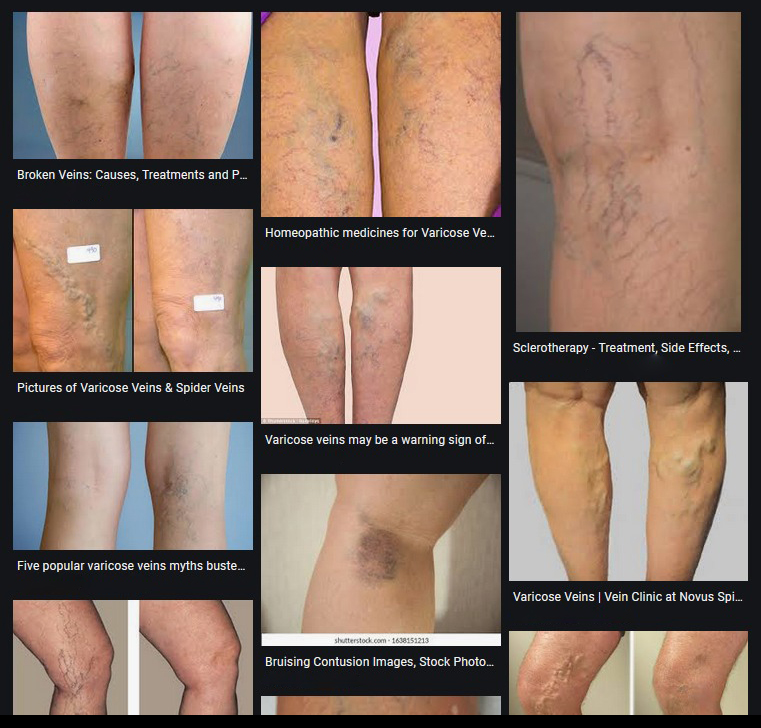
From an ergonomic standpoint, all Ergomat matting with distinct surface profiles provide the necessary, appropriate stimulation to be considered an ergonomic mat.
From a user comfort standpoint, preferred profiles are a matter of personal choice.
In general our polyurethane mats provide appropriate solutions for dry, non-abrasive to slightly damp or oily environments. Polyurethane mats also have anti-static properties.
Rubber mats have greater heat resistance, anti-abrasion and anti-slip properties for more demanding industrial conditions.
In addition, because they are closed-cell, Ergomat rubber mats will not harbor bacteria, making them ideal for critical environments like medical and food processing facilities.
Rubber mats are more resistant to a broader range of PH conditions. The Ergomat Nitril also comes in an ESD version for static sensitive manufacturing environments.
For the most appropriate mat for your specific working environment or industry,
please consult the information Industry Applications dropdown menu.
Polyurethane vs. Nitril

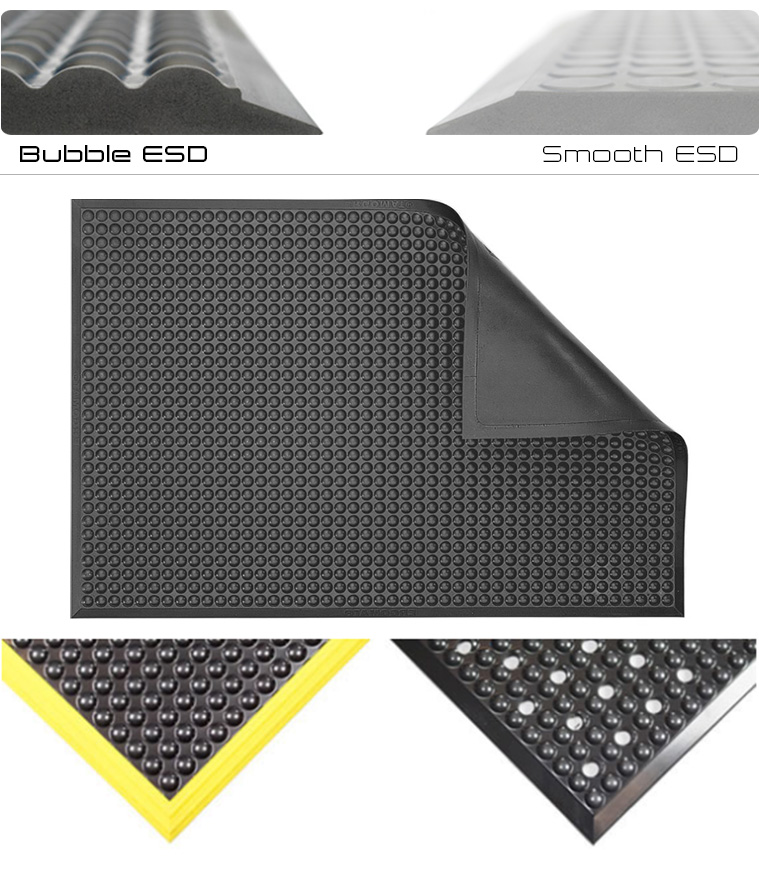
AB Classic is the original ergonomic bubble profile mat.
Customers still have many of these original mats in service for 20 years or longer.
- Molded in durable, lightweight virgin polyurethane
- For use in dry, non-abrasive environments
- Can be customized in any shape and size
- Always beveled on every edge
- Service temperature range 5⁰C (40⁰F) to 35⁰C (95⁰F)
- Anti-static properties
- ISO Cleanroom Class 5 (Class 100) rated
- Available with yellow bevel
- Silicone and latex free
- 8 year warranty
IMPORTANT NOTE:
ESD safe Anti-Fatigue mat can only remove static charge
if the mat is connected to earth by means of an "Earth Wire with Grounding Plug"
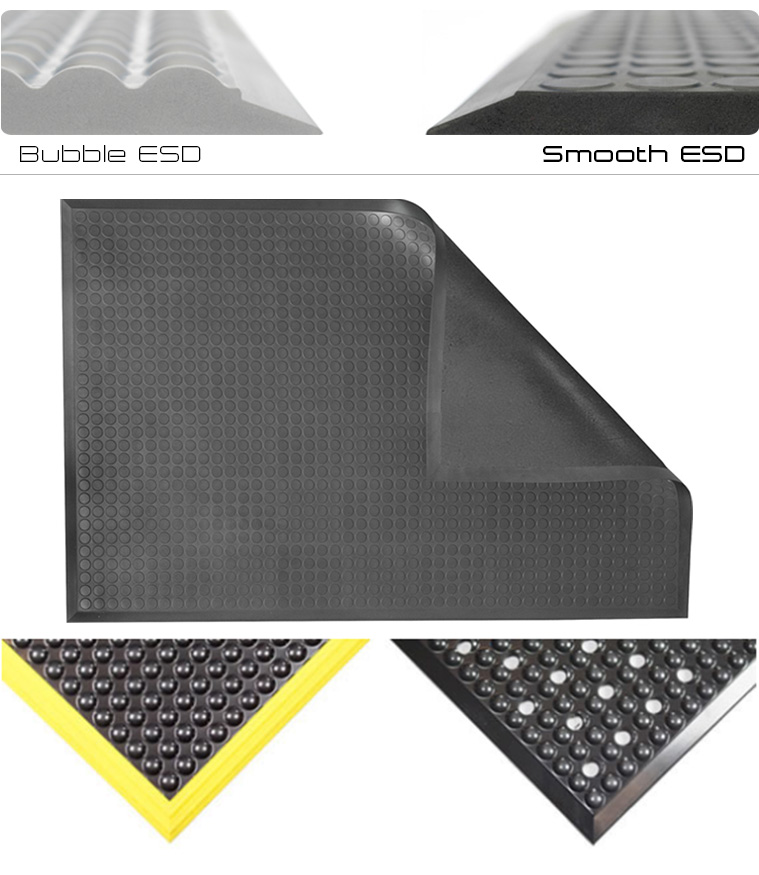
The Classic Deluxe is the ultimate smooth ergonomic flat mat.
This durable 5/8" thick molded polyurethane mat is designed to provide ergonomic relief without hindering the movement of workers whose work process requires pivoting.
The Classic Deluxe is ideal for dry, non-abrasive environments requiring static control.
- Available in dark charcoal
- Molded in durable, lightweight virgin polyurethane
- For use in dry, non-abrasive environments
- Can be customized in any shape and size
- Always beveled on every edge
- Service temperature range 5°C (40°F) to 35°C (95°F)
- Anti-static properties
- ISO Cleanroom Class 5 (Class 100) rated
- Available with yellow bevel
- Silicone and latex free
- Warranty up to 8 years depending on application
IMPORTANT NOTE:
ESD safe Anti-Fatigue mat can only remove static charge
if the mat is connected to earth by means of an "Earth Wire with Grounding Plug"
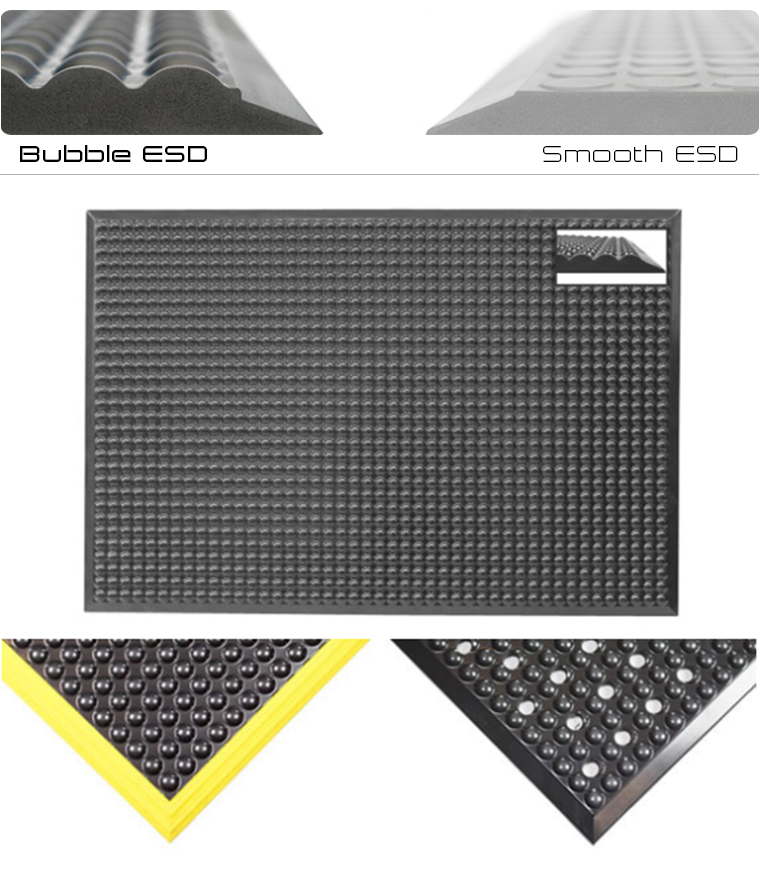
AFB Complete Bubble adds enhanced ESD protection to the versatility of the AFB Complete Bubble.
In addition to its ESD properties, the AFB Complete Bubble is fire-retardant and resistant to mild exposures of oils and other liquids.
- Molded in durable, lightweight, virgin polyurethane
- Resistant to mild exposures of oils and other liquids
- Fire-retardant according to standard EN 13501-1
- Can be customized in any shape and size
- Always beveled on every edge
- Service temperature range from 5°C (40°F) to 35°C(95°F)
- ESD (Electrical Resistance 1x108 ? - 4x108 ?)
- ISO Cleanroom Class 5
- Yellow bevel optional
- Silicone and latex free
IMPORTANT NOTE:
ESD safe Anti-Fatigue mat can only remove static charge
if the mat is connected to earth by means of an "Earth Wire with Grounding Plug"
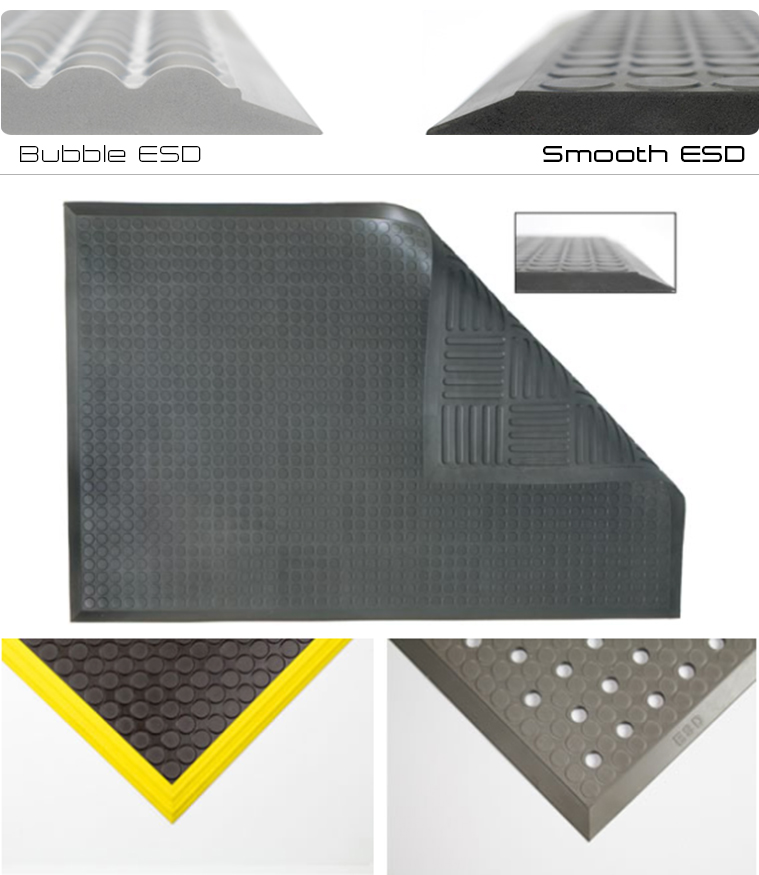
AFS Complete Smooth ESD is a feature rich ergonomic mat that can tolerate mild exposure to oils and other liquids
while providing enhanced protection against static electricity. It is self-extinguishing when introduced to open flame,
which qualifies the AFS Complete Smooth ESD as fire-retardant according to standard EN 13501-1.
- Available in Light-Grey
- Molded in durable, lightweight virgin polyurethane
- Tolerates mild exposures to oil and other liquids
- Electrical resistance : 1x10^8Ω – 6x10^8Ω
- Fire-retardant
- Can be customized in any shape and size
- Always beveled on every edge
- Service temperature range 5⁰C (40⁰F) to 35⁰C (95⁰F)
- ISO Cleanroom Class 5 (Class 100) rated
- Available with yellow bevel
- Silicone and latex free
- 5 year warranty
IMPORTANT NOTE:
ESD safe Anti-Fatigue mat can only remove static charge
if the mat is connected to earth by means of an "Earth Wire with Grounding Plug"

EFB Complete Bubble adds enhanced ESD protection to the versatility of the EFB Complete Bubble.
In addition to its ESD properties, the EFB Complete Bubble is fire-retardant and resistant to mild exposures of oils and other liquids.
- Molded in durable, lightweight, virgin polyurethane
- Resistant to mild exposures of oils and other liquids
- Fire-retardant according to standard EN 13501-1
- Can be customized in any shape and size
- Always beveled on every edge
- Service temperature range from 5°C (40°F) to 35°C(95°F)
- ESD (Electrical Resistance 1x108 ? - 4x108 ?)
- ISO Cleanroom Class 5
- Yellow bevel optional
- Silicone and latex free
IMPORTANT NOTE:
ESD safe Anti-Fatigue mat can only remove static charge
if the mat is connected to earth by means of an "Earth Wire with Grounding Plug"

EFS Complete Smooth ESD is a feature rich ergonomic mat that can tolerate mild exposure to oils and other liquids
while providing enhanced protection against static electricity. It is self-extinguishing when introduced to open flame,
which qualifies the EFS Complete Smooth ESD as fire-retardant according to standard EN 13501-1.
- Available in Light-Grey
- Molded in durable, lightweight virgin polyurethane
- Tolerates mild exposures to oil and other liquids
- Electrical resistance : 1x10^8Ω – 6x10^8Ω
- Fire-retardant
- Can be customized in any shape and size
- Always beveled on every edge
- Service temperature range 5⁰C (40⁰F) to 35⁰C (95⁰F)
- ISO Cleanroom Class 5 (Class 100) rated
- Available with yellow bevel
- Silicone and latex free
- 5 year warranty
IMPORTANT NOTE:
ESD safe Anti-Fatigue mat can only remove static charge
if the mat is connected to earth by means of an "Earth Wire with Grounding Plug"

The Complete Deluxe is the premier, fire-retardant, ergonomic flat mat.
It offers static control as well as resistance to mild liquid exposures, including oils and non-abrasive environments.
The resilient flat profile accommodates the movements of workers whose physical work process requires significant pivoting.
- Available in dark charcoal
- Molded in durable, lightweight virgin polyurethane
- For use in dry, non-abrasive environments
- Can be customized in any shape and size
- Always beveled on every edge
- Service temperature range 5°C (40°F) to 35°C (95°F)
- Anti-static properties
- ISO Cleanroom Class 5 (Class 100) rated
- Available with yellow bevel
- Silicone and latex free
IMPORTANT NOTE:
ESD safe Anti-Fatigue mat can only remove static charge
if the mat is connected to earth by means of an "Earth Wire with Grounding Plug"

Infinity Bubble ESD combines the exceptional ergonomics of a durable polyurethane bubble mat
with the additional advantages of enhanced static control,
easy clean-ability and broad resistance to incidental chemical and liquid spills due to its closed-cell, non-porous surface.
- Available in: Black, White, Silver, Blue and Stainless.
- Molded in durable, lightweight virgin polyurethane
- Electrical resistance : 1x10^8Ω– 5x10^8Ω
- For use in dry, non-abrasive environments
- Can be customized in any shape and size
- Always beveled on every edge
- Service temperature range 5⁰C (40⁰F) to 35⁰C (95⁰F)
- Anti-static properties
- ISO Cleanroom Class 5 (Class 100) rated
- Available with yellow bevel
- Silicone and latex free
- Warranty up to 12 years depending on application
IMPORTANT NOTE:
ESD safe Anti-Fatigue mat can only remove static charge
if the mat is connected to earth by means of an "Earth Wire with Grounding Plug"
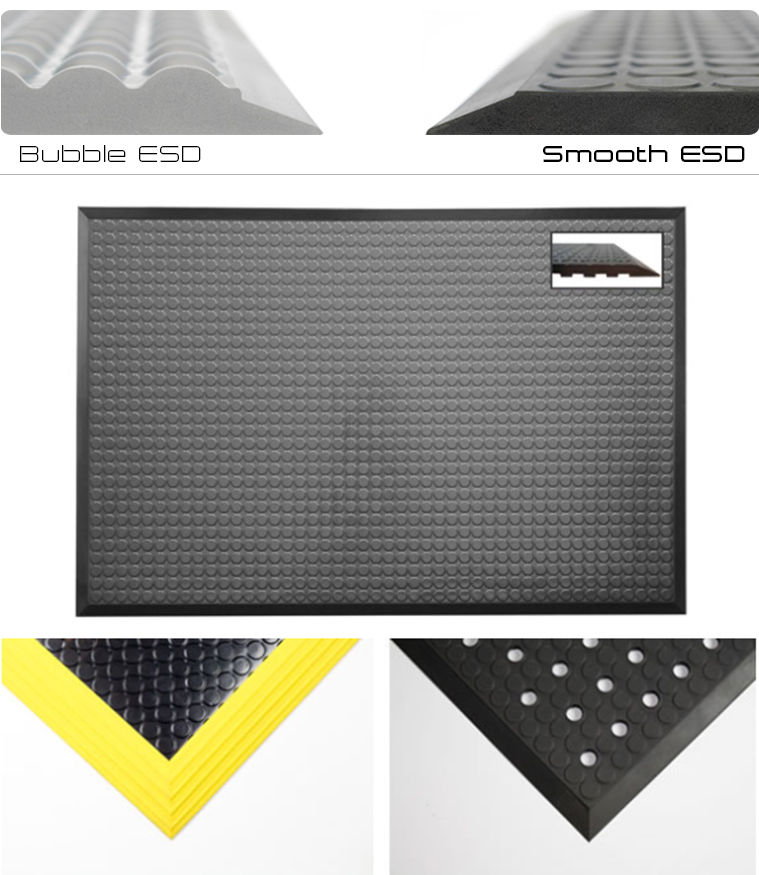
Infinity Smooth ESD is a durable polyurethane flat surface anti-fatigue mat engineered with enhanced static control.
It accommodates pivoting workers and facilitates cart and trolley accessibility while offering the additional advantages
of easy clean-ability and broad resistance to incidental chemical and liquid spills due to its closed-cell non –porous surface.
- Available in: Black, Blue, Silver, Stainless, White
- Molded in durable, lightweight virgin polyurethane
- Electrical resistance : 3x10^8Ω – 8x10^8Ω
- For use in dry, non-abrasive environments
- Can be customized in any shape and size
- Always beveled on every edge
- Service temperature range 5⁰C (40⁰F) to 35⁰C (95⁰F)
- ISO Cleanroom Class 5 (Class 100) rated
- Available with yellow bevel
- Silicone and latex free
IMPORTANT NOTE:
ESD safe Anti-Fatigue mat can only remove static charge
if the mat is connected to earth by means of an "Earth Wire with Grounding Plug"

The Infinity Deluxe is the ultimate flat surface ergonomic mat. This 5/8”/1.5cm thick resilient polyurethane mat
is engineered to provide both cushion and rebound to deliver exceptional ergonomic relief
without hindering the movement of pivoting workers.
It offers the additional advantages of easy clean-ability and broad resistance
to incidental chemical and liquid spills due to its closed-cell, non-porous surface.
- Available in black, blue, silver and stainless.
- Molded in durable, lightweight virgin polyurethane
- For use in dry, non-abrasive environments
- Can be customized in any shape and size
- Always beveled on every edge
- Service temperature range 5°C (40°F) to 35°C (95°F)
- Anti-static properties
- ISO Cleanroom Class 5 (Class 100) rated
- Available with yellow bevel
- Silicone and latex free
IMPORTANT NOTE:
ESD safe Anti-Fatigue mat can only remove static charge
if the mat is connected to earth by means of an "Earth Wire with Grounding Plug"
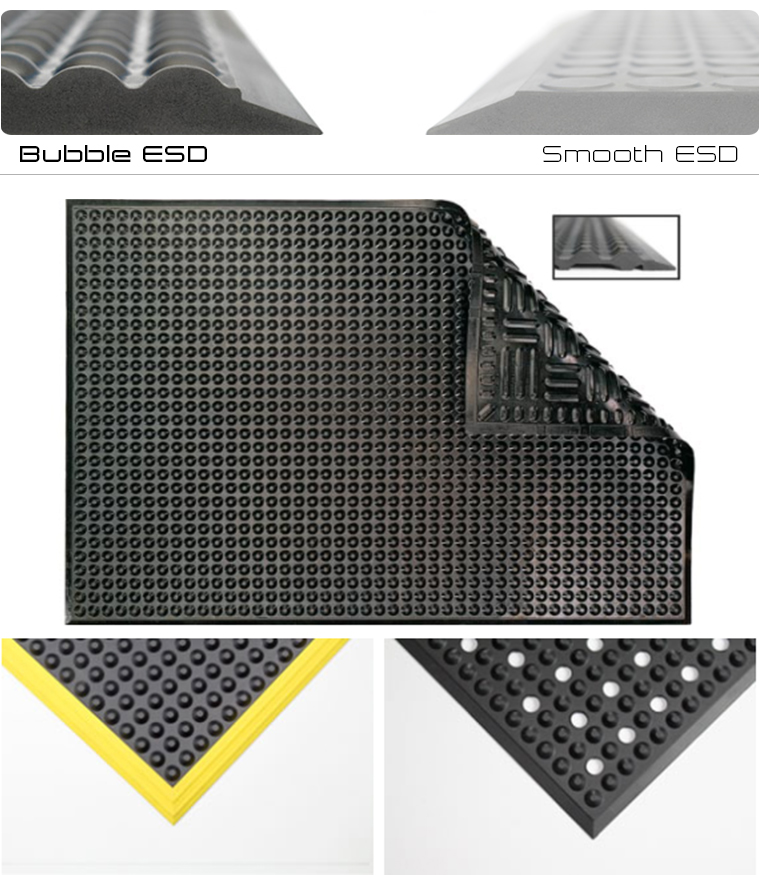
Nitril Bubble ESD/Conductive is a perfect ergonomic mat for critical environments requiring a high degree of static control to protect sensitive products or equipment.
In situations with excessive fluid volume, or the need to promote air flow, Nitril ESD/Conductive can be die-cut to accommodate these requirements.
This mat is typically used in electronics assembly and semiconductor production among others.
Grounding cords can also be supplied for added protection.
- Available in Black
- Virgin nitrile rubber
- Can be customized in any shape and size
- Electrical resistance : 5x10^4Ω - 1.5x10^5Ω
- Always beveled on every edge
- Service temperature range -40⁰C (-40⁰F) to 90⁰C (195⁰F)
- ISO Cleanroom Class 5 (Class 100) rated
- Autoclavable 60cm x 90cm (2’ x 3’)
- Can be pressure washed to 1,500 PSI
- pH resistance from 5-10
- Can be provided with die-cut holes for liquid and air flow
- Silicone and latex free
- Grounding cords can be supplied for added protection
IMPORTANT NOTE:
ESD safe Anti-Fatigue mat can only remove static charge
if the mat is connected to earth by means of an "Earth Wire with Grounding Plug"
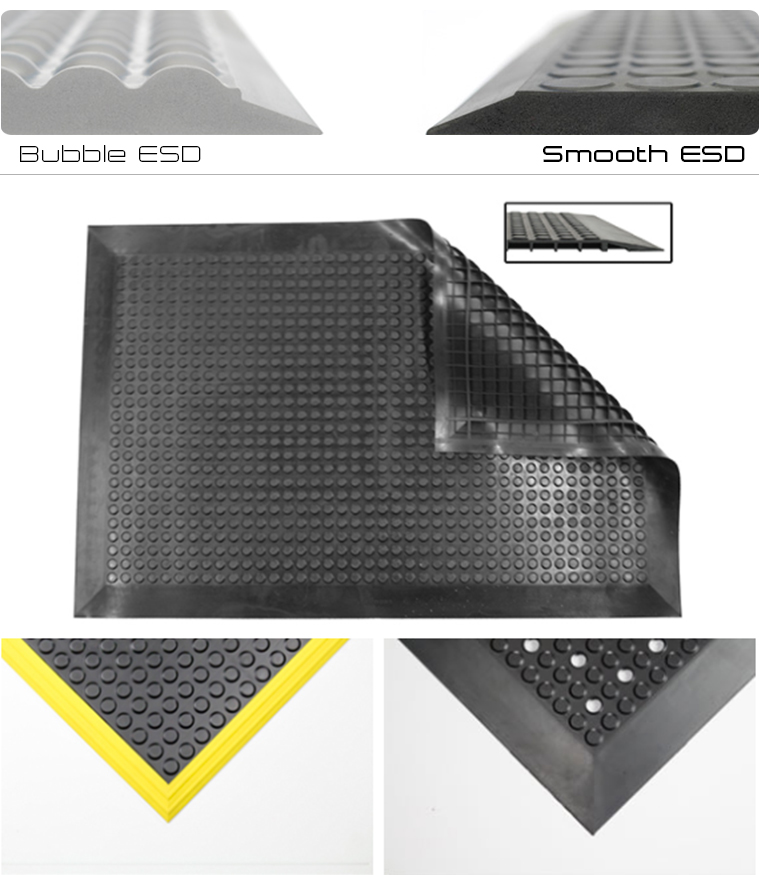
Nitril Smooth ESD/Conductive is an ideal flat mat for critical environments where static dissipation is necessary and carts or trolleys must be accommodated.
It is an exceptional solution for electronics assembly operations or laboratories where spills of various volatile materials are possible.
Although most sizes of mat can be accommodated within several inches, the construction of this mat limits the ability to make it in exact size and shape.
- Available in Black
- Virgin nitrile rubber
- Can be customized in any shape and size
- Electrical resistance : 2.8x10^4Ω–4.5x10^4Ω
- Always beveled on every edge
- Can be supplied with 1” yellow bevel (non-conductive)
- Service temperature range -40⁰C (-40⁰F) to 90⁰C (195⁰F)
- ISO Cleanroom Class 5 (Class 100) rated
- Autoclavable 60cm x 90cm (2’ x 3’)
- pH resistance from 5-10
- Silicone and latex free
- Grounding cords can be supplied for added protection
IMPORTANT NOTE:
ESD safe Anti-Fatigue mat can only remove static charge
if the mat is connected to earth by means of an "Earth Wire with Grounding Plug"
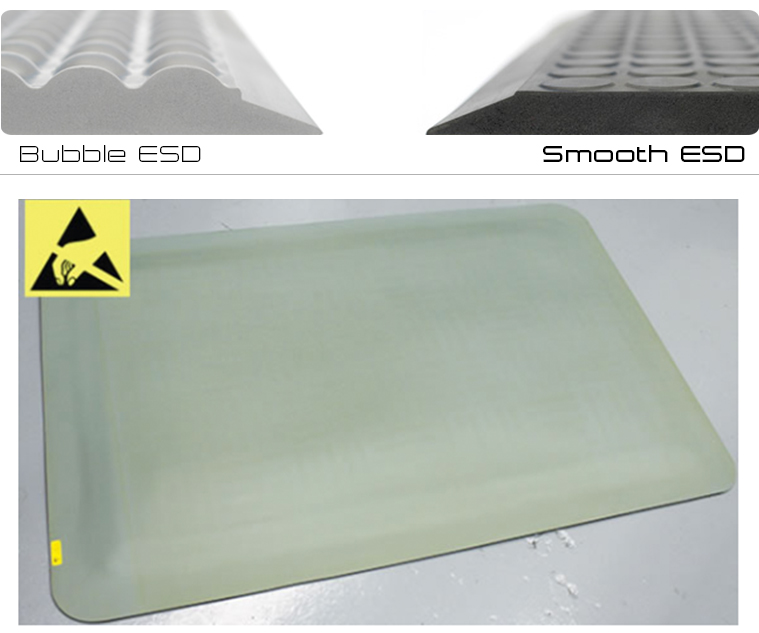
The Optimal Smooth ESD mat is an exceptional anti-fatigue mat with electrical resistance of 5x106 Ω and an ISO Class 3 cleanroom rating.
This durable triple layer mat consists of a smooth, chemical resistant, easy to clean top and bottom layer with a layer of foamed EPDM rubber in between.
The foam layer is recessed from all sides of the mat, creating a natural bevel around the perimeter for safety.
- Available in Grey
- Electrical resistance of 5x10^6 Ω
- ISO Cleanroom Class 3 rated
- Latex and Silicone free
- Only available in a size 2’x3’ (60x90cm)
IMPORTANT NOTE:
ESD safe Anti-Fatigue mat can only remove static charge
if the mat is connected to earth by means of an "Earth Wire with Grounding Plug"
The Circulatory System
An expanding body of research exists which addresses standing work positions and the potential damage.
The general conclusion of this research is that floor mats are an important element in injury prevention efforts.
Blood flows from the heart through the arteries to the extremities. When you walk, it is pumped back through the veins by the interaction between muscles and veins.
This mechanism is commonly referred to as the venous pump. When you stand, gravity will make fluids settle in feet and legs and because of the reduced muscle activity, the venous pump is less effective.
This causes increased pressure on the walls of the venous pump veins, which leads to long-term damage and swelling which causes pain and discomfort.
How The Venous Pump Works
Figure 1 shows a muscle (in red) at rest next to a vein. Flapper valves in the vein allow blood to flow up from below but not down from above (illustrated by the arrows).
In Figure 2, the muscle contracts and exerts pressure on the side of the vein.
This causes blood to flow up through the valve above while the valve below remains closed ensuring proper circulation towards the heart (Figure 3).

Damaged Veins
Prolonged standing on a hard surface will lead to damaged veins.
This damage occurs as pressure inside the veins builds up and expands the sides of the vein.
As the years go by, the vein becomes permanently expanded and the flaps that make up the valves are no longer able to reach together.
The Anti-Fatigue Mat Advantage
Anti-fatigue mats were developed specifically to solve the problems of short-term fatigue and long-term injury associated with standing work positions.
Our product line represents the most advanced technology for this purpose available in the marketplace today.
By providing an elastic surface to stand on, an Anti-fatigue stimulates muscle activity in feet and legs.
As described above, this is important for the proper function of the venous pump and hence for the prevention of fatigue and injury.
This thermal photograph compares circulation in the lower body of a standing worker. The image on the right shows the worker standing on an Anti-fatigue.
Red and yellow tones indicate higher skin temperatures resulting from stimulated muscle activity and hence circulation in the legs and feet,
promoted by the Anti-fatigue 's unique elastic properties and proprietary polymer formulation.
The image on the left shows circulation patterns without the Anti-fatigue. Blues and greens in this image are evidence of poor circulation,
a reliable predictor of fatigue and muscle disorders.

How does an ergonomic mat work?
Ergomat ergonomic mats are designed to stimulate circulation in feet, legs and lower back. Circulation is stimulated by the unique, patented surface profile of Ergomat mats, which forces muscular response.
Ergomat mats are true ergonomic mats; they are carefully engineered to provide the optimal balance between compression and resistance, which is critical to achieving the appropriate muscle stimulation.
The best way to understand what an ergonomic mat is designed to do is to compare it to the suspension of a car. Like the suspension, it absorbs and disperses shock, while providing the necessary support for stability.
Why is ergonomic matting important?
Like all ergonomic tools, ergonomic matting is designed to work with the human body to ease the tasks that the body performs.
In the case of a standing work station, these mats are of critical importance in reducing or eliminating short-term fatigue and discomfort, as well as long-term negative cumulative effects of strain and stress injury.
These benefits also lead to real savings through increased productivity and worker moral, and decreases in sick leave, workers' compensation claims and substandard production due to operators' lack of concentration caused by fatigue.
When is it a good idea to use a 'smooth' mat (an anti-fatigue mat)?
A smooth mat will reduce fatigue and strain of standing while working. It is ideal for areas where carts and trolleys are used and where frequent walking may occur or heels may be worn.
Advantages and benefits of Ergomat anti-fatigue and ergonomic mats for employees:
- They stimulate blood circulation and prevent cramps
- They reduce fatigue and minimize the number of industrial accidents
- They increase workplace safety
- They improve the working environment and increase job satisfaction
- They reduce sick leave
- They reduce the costs associated with sickness/absence
- They lead to increased productivity and may increase earnings
Why are there so many choices?
The various mats in the Ergomat family of ergonomic matting are designed to provide optimal solutions for specific industries and working conditions.
Rather than selling mats, we prefer to provide real, long lasting comprehensive solutions for industry specific workplace environments.
The Proof Is In The Research
Over the past 20 years, academics have undertaken a number of narrowly defined research projects that have looked at discrete variables relating to fatigue, muscle problems, and chronic injuries resulting from standing work postures.
These studies have been narrowly defined because a comprehensive look at these factors would require considering too many synergistic relationships and would have to be conducted over an exceptionally extended period of time.
Consequently, objective long-term studies comparing the cumulative effects of standing on a concrete or block floor vs. standing on an Ergomat, vs. standing on other mat styles or brands have not been undertaken.

We are able to provide you with a fairly comprehensive collection of academic studies, which when considered together start to build the analytic case you have requested,
but still fall short of providing an easily understood, definitive answer.
Contemporary research indicates that there is a correlation between blood accumulation in the feet and legs (venous pooling) and the fatigue experienced by standing workers.
Increased muscle activity in the lower extremities, which is indicated by increased temperature, combats venous pooling.
In static working conditions like assembly line or workstation environments, it has been shown that Ergomat's design, which incorporates a firm but varied surface profile and
a rapid return from compression shock, contributes favorably to the reduction of venous pooling, and by logical extension, fatigue.
Please note in particular the article entitled "The Role of Mechanical Properties in the Ergonomic Performance of Commercial Mats"
which is used on an Ergomat competitor's website, even though the study concludes that Ergomat provides the superior product.
In addition to "The Role of Mechanical Properties in the Ergonomic Performance of Commercial Mats",
the zipped Academic Research file contains articles that more directly deal with the impact of matting on a standing worker.
- A Summary of Ergonomic Studies of Anti-fatigue Mats
- The Influence of Floor Surface Hardness on Muscle Activation, Coordination and Fatigue During Long –Term Static Standing
- Subjective, Physiological and Biomechanical Response to Manual Work Performed Standing on Hard and Soft Surfaces
- Improved Ergonomics for Standing Work
- The Effect of Mats on Back and Leg Fatigue
For more information, we also have three more general analyses of the effects resulting from prolonged standing work postures.
- Significant Method in Determining the Effect of Prolonged Standing in Industries
- A Review on Health Effects Associated with Prolonged Standing in the Industrial Workplaces
- Assessment of Muscle Fatigue Associated with Prolonged Standing in the Workplace
Taken together, this collection of studies makes the case that workers standing on hard surfaces experience fatigue, as do workers standing on excessively cushioned surfaces.
The ideal mat provides the proper balance between shock absorption and rebound. They also suggest that attention to workplace ergonomics improves alertness, productivity, and safety.
Conversely, neglecting workplace ergonomics can have both short-term and long-term detrimental effects on worker safety and health.

1) How does an ergonomic mat work?
Ergonomic mats like the ERGOMATs are designed to stimulate circulation in feet, legs and lower back. Circulation is stimulated by the unique surface profiles of the ERGOMATs, which force muscular response. True ergonomic mats like the ERGOMAT are carefully engineered to provide the optimal balance between compression and resistance, which is critical to achieving the appropriate muscle stimulation. The best way to understand what an ergonomic mat is designed to do is to compare it to the suspension of a car. Like the suspension, it absorbs and disperses shock, while providing the necessary support for stability.
2) Why is ergonomic matting important?
Like all ergonomic tools, ergonomic matting is designed to work with the human body to ease the tasks that the body performs. In the case of a standing worker, these mats are of critical importance in reducing or eliminating short-term fatigue and discomfort, and the more long-term negative cumulative effects of strain and stress injury. As a practical consideration, these benefits lead to real savings through increased productivity and worker moral, and decreases in sick leave, workers compensation claims and substandard production due to operator inattention caused by fatigue.
3) Why does ERGOMAT offer so many choices?
The various mats in the ERGOMAT family of ergonomic matting are designed to provide optimal solutions for specific industries and working conditions. Rather than selling mats, we prefer to provide real, comprehensive solutions to industry specific workplace environments.
4) Slippery mat? We have solutions!
Ergomat offers two options for keeping mats in place.
For mats that will not be moved, DuraStripe can be installed on the bevels around the perimeter of the mat to securely fix the mat to the floor. This method also allows for a contrasting color bevel to serve as an additional safety reminder.
For mats that must be moved regularly for cleaning or other reasons, we can add an additional material with aggressive gripping properties to the bottom of the mat to hold it firmly in place.
5) Can ERGOMATs create a tripping hazard?
Unlike many other mats, which are extruded in long runners with a variety of sandwiched materials, our premium ERGOMATs are molded mats consisting of the highest quality virgin materials. This gives ERGOMAT the unique ability to customize our matting, and fit it to the exact dimensions of any working environment in any size or shape. The ability to customize in this way allows us to bevel every exposed edge of a mat, virtually eliminating any tripping hazards. In addition, the use of high quality, consistent virgin materials keeps the ERGOMATs from expanding or shrinking, which causes curling and creates tripping hazards in other matting.
6) How do I clean ERGOMAT matting?
All ERGOMATs can be swept, vacuumed or mopped. The nitrile and EPDM rubber mats can also be hosed, power washed or steam cleaned. These rubber mats are also autoclavable in 60cm x 90cm foot sizes, as long as they are cooled and dried flat.
7) Why can only 60cm x 90cm rubber mats be autoclaved?
The virgin Nitril or EPDM rubber can withstand numerous cycles of autoclave heat, but over time the bonding agent used to build out larger mats will weaken the seams in the mat, and can cause them to come apart.
8) What is the difference between polyurethane and rubber mats?
From an ergonomic standpoint, all ERGOMAT's with distinct surface profiles provide the necessary, appropriate stimulation. From a user comfort standpoint, preferred profiles are a matter of personal choice. In general our polyurethane mats provide appropriate solutions for dry, non-abrasive to slightly damp or oily environments. Polyurethane mats also have anti-static properties.
Rubber mats have greater heat resistance, anti-abrasion and anti-slip properties for more demanding industrial conditions. In addition, because they are closed-cell, ERGOMAT rubber mats will not harbor bacteria, making them ideal for critical environments like medical and food processing facilities. Nitrile rubber mats are more resistant to acidic conditions, (pH < 7) and EPDM rubber performs better in caustic, or basic environments (pH > 7). The ERGOMAT Nitril also comes in an ESD version for static sensitive manufacturing environments.
For the most appropriate mat for your specific working environment or industry, please consult information contained elsewhere on this website, or in ERGOMAT literature.





